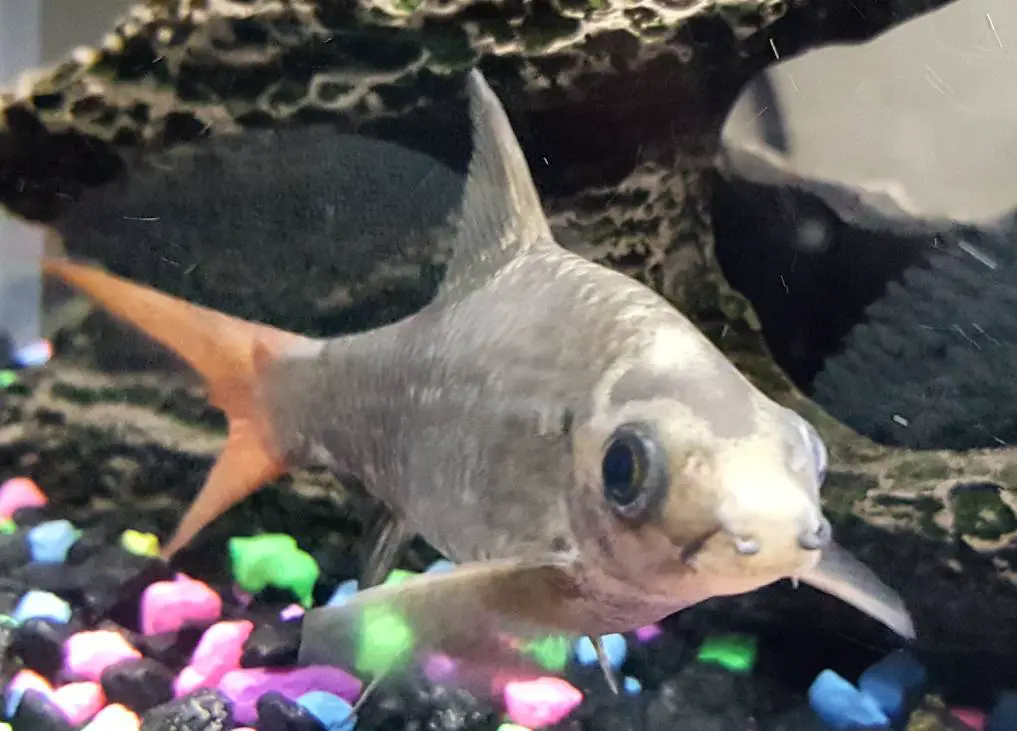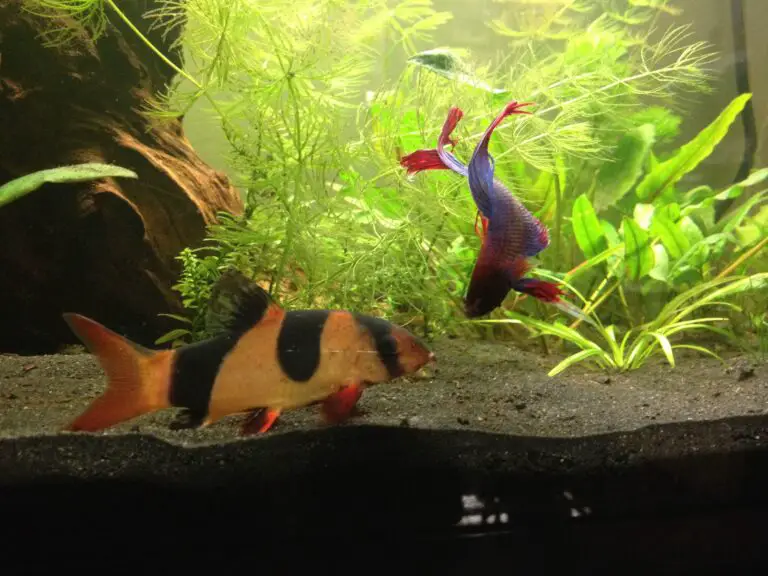Why is My Red Tail Shark Losing Color?
A red tail shark losing its color can be a sign of stress and illness. The most common cause is poor water quality, such as high levels of ammonia or nitrite caused by overfeeding or inadequate filtration.
Poor nutrition, aggression from other fish, overcrowding and sudden changes in temperature can also contribute to the loss of color.
If you notice your red tail shark losing its vibrant coloring it’s best to immediately check your aquarium parameters for signs of poor water quality and make sure that all other factors are being met correctly.
If the problem persists then you should consider taking your fish to a vet for further examination and treatment if necessary.
If you’ve noticed that your red tail shark has been losing its vibrant color, it could be a sign of stress or illness. This species is naturally very sensitive to changes in water conditions, and any rapid shifts can cause them to develop health problems.
If the change in color persists for more than a few days, it may be time to have your fish checked out by an aquarium specialist as soon as possible.
With proper care and attention, most illnesses can be avoided and treated effectively before they become serious issues.

Credit: www.myaquariumclub.com
What Diseases Do Red Tail Sharks Have?
Red tail sharks are a type of fish that can be found in many aquariums, but they can also be prone to certain diseases. Some of the most common diseases that red tail sharks experience include bacterial infections, parasitic infestations, and fungal growths.
Bacterial infections such as columnaris and fin rot can cause damage to their fins and other body parts; these bacteria thrive in warm water environments so it’s important for fishkeepers to maintain good filtration and circulation in order to keep their tanks clean.
Parasitic infestations like Ich (Ichthyophthirius multifillis) or flukes (Gyrodactylus spp) may result from poor tank maintenance since these organisms often hitchhike on live food or plants imported into aquariums.
Fungal growths like Saprolegnia also thrive in warm water and can cause skin lesions if left untreated. While some of these diseases might seem intimidating at first glance, they are actually very treatable with proper medication; luckily there are a variety of medications available for purchase online or at local pet stores that will help eradicate any signs of disease within your tank quickly and effectively.
How Do You Keep a Red Tailed Black Shark?
Keeping a Red-Tailed Black Shark (RTBS) is not for the faint of heart. This type of shark requires a very large aquarium with plenty of space to swim and explore, as they can reach up to 16 inches in length and are known for their active swimming behavior.
To ensure that your RTBS has the best environment possible, you should have enough room for it to move between water temperatures ranging from 77°F – 82°F and you will need an appropriate filtration system to keep the water clean.
Additionally, live rock or other decorations should be added to provide places for the shark to hide when feeling stressed or threatened. It is also important that you feed your RTBS small pieces of food such as frozen brine shrimp multiple times per week; however overfeeding can lead to health problems so moderation is key!
Finally, because these sharks prefer company it’s always recommended that owners house them in pairs or groups whenever possible – this way they can feel more secure and comfortable in their home.
With these simple tips in mind, keeping an RTBS can be both rewarding and enjoyable!
What Should I Feed My Red Tail Shark?
When it comes to feeding your Red Tail Shark, you want to make sure that their diet consists of a variety of foods. A good diet for these fish includes live and frozen foods such as bloodworms, brine shrimp, blackworms, tubifex worms, etc., as well as some prepared sinking pellets or flakes.
Be sure to only feed them what they can eat in 2 minutes or less; any uneaten food should be removed from the tank with a net so it doesn’t contaminate the water.
You may also need to supplement their diets with some vegetable matter such as zucchini slices and blanched spinach leaves. Variety is key when it comes to keeping your shark healthy!
Additionally, you should always remember not to overfeed since this can lead to malnutrition and poor health.
Lastly, if possible try adding different types of fresh seafood like mussels or squid occasionally into the mix-up too!
What Temperature Do Red Tail Sharks Like?
Red tail sharks are a species of freshwater fish that are native to South East Asia. They prefer temperatures between 75-80 degrees Fahrenheit, meaning they require a relatively warm environment to thrive.
These tropical fish need plenty of open swimming space and good water quality in order to stay healthy and comfortable.
Red tail sharks also enjoy areas with strong currents as this helps keep their gills oxygenated and encourages them to be active.
To maintain optimal health, it is best to keep the temperature between 78-82 F and ensure that there are no sudden changes in temperature or pH levels within the tank.
If the conditions become too cold for these fish, they will become lethargic and ultimately die due to stress-related issues such as infection or disease.
The Only Red Tail Shark Video You Need to Watch (Epalzeorhynchos Bicolor) – Care, Breeding Tankmates
Rainbow Shark Losing Color
The Rainbow Shark is a freshwater fish that has gained popularity in the aquarium hobby. Unfortunately, due to overbreeding and poor water quality, some specimens of this species may suffer from color loss.
This can be caused by stress or disease, and it is important for aquarists to monitor their water parameters closely in order to keep these beautiful fish looking vibrant.
Providing a healthy diet and proper environment will help ensure your Rainbow Sharks stay colorful and healthy.
Red Tail Shark Turning Grey
The Red Tail Shark, or Epalzeorhynchos bicolor, is a freshwater species of fish that is native to Southeast Asia. As its name implies, this species has a bright red tail and can grow up to 6 inches in length.
However, it should be noted that the Red Tail Shark’s coloration can change over time; some individuals may begin to develop grey patches on their fins and body due to stress or environmental changes.
It is important for aquarium owners to monitor their aquatic environment – such as water chemistry – in order to ensure their Red Tail Sharks remain vibrant and healthy.
Why is My Red Tail Shark Hiding?
If your red tail shark is hiding, it may be because they are feeling stressed or scared. Red tail sharks are naturally shy fish and tend to hide when they feel threatened or uncomfortable.
They also like to hide in dark areas of their tank where they feel safe and can observe their surroundings without being seen.
It’s important that the water parameters in the tank remain stable so that your red tail shark doesn’t become too stressed out, as this could lead to serious health issues.
Why Do My Red Tail Sharks Keep Dying?
If you’re having trouble with your red tail sharks dying, there are a few things to consider. The most common cause of death for red tail sharks is poor water quality.
Make sure your aquarium has the correct pH level and temperature as well as an adequate filtration system that keeps the tank clean and free from ammonia, nitrites, and nitrates.
Additionally, overfeeding can lead to health problems in fish, so make sure to only feed them what they need and no more.
Finally, be aware that red tail sharks can become aggressive towards other fish if not kept in a large enough group or if kept with incompatible species; this could also lead to their untimely demise.
Fin Rot Red Tail Shark
Fin rot is a common disease among Red Tail Sharks, caused by bacterial infection or poor water quality. It manifests as discoloration and erosion of the sharks’ fins and tail, leading to difficulty swimming and decreased appetite.
Fin rot can be treated with antibiotics or salt baths, but prevention is best achieved through proper water maintenance, including regular partial water changes.
Red Tail Shark Acting Weird
If you own a red tail shark, it’s important to be aware of potential signs that they may not be feeling well. If your red tail shark is acting unusually lethargic or swimming erratically, this may indicate that something is wrong with their environment or health.
Be sure to check water parameters such as temperature and pH levels, as even slight changes can cause stress in fish.
Additionally, watch for any visible signs of illness such as white spots on the fins or body discoloration which could indicate parasites or bacterial infections.
Red Tail Shark White Patches
The red tail shark is a unique looking fish with striking white patches along its body. It is native to Southeast Asia and can be found in the large river basins of Thailand, Malaysia, and Indonesia.
The red tail shark gets its name from its bright pinkish-red tail fin and it has small eyes located on either side of its head.
While they are peaceful fish when kept alone or in groups of their own kind, they tend to become more aggressive when mixed with other species.
Red Tail Shark Not Swimming
The red tail shark is a species of fish that normally swims in the upper and mid levels of an aquarium tank. However, if it stops swimming or appears to be struggling, this could be a sign that something is wrong.
It may indicate disease, stress or even injury and should prompt further investigation into the health of your fish.
Conclusion
In conclusion, it is important to understand why your red tail shark may be losing color. There are a variety of possible causes from improper water conditions or tank mates to stress and illness.
Knowing the signs and symptoms associated with each condition can help you quickly identify what might be causing the loss of color in your fish.
If all else fails, seek professional guidance from a qualified veterinarian as soon as possible for further diagnosis and treatment.




